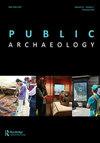Eliciting Historical Thinking: The Use of Archaeological Remains in Secondary Education
IF 0.9
4区 历史学
0 ARCHAEOLOGY
引用次数: 0
Abstract
This paper investigates the expression of historical thinking by students in the school and museum environment, based on the study of the past through archaeological remains. The empirical investigation was carried out in five schools in Athens, four state and one private, and included a total sample of 189 middle and high school students (12–13 and 15–16-year-olds). The students were exposed to archaeological remains in three different forms, actual physical objects, printed images of the objects, and digital representations thereof. Data was collected from written responses to a questionnaire and from their responses during a semi-structured interview, as well as from observations by the researcher during the whole process. Based on an analysis of their responses, it was clear that most of the students had grasped the historical significance of the archaeological remains they had studied. They referred to them in relation to their historical context, based on their recollection of pre-existing historical knowledge or the use of relevant information given to them. However, the expression of interpretative historical thinking in several responses appears to be influenced by the historical or non-historical character of each question or task, as well as the type of archaeological remains they had studied. Parameters such as age, gender, and socio-cultural background also appear to have influenced their expression of historical thinking.启发历史思维:考古遗迹在中等教育中的运用
本文在通过考古遗迹研究过去的基础上,调查了学生在学校和博物馆环境中的历史思维表达。实证调查在雅典的五所学校进行,四所公立学校和一所私立学校,包括189名初高中学生(12-13岁和15 - 16岁)。学生们接触了三种不同形式的考古遗迹:实物、实物打印图像和数字表示形式。数据收集自对问卷的书面答复和他们在半结构化访谈中的回答,以及研究人员在整个过程中的观察。根据对他们回答的分析,很明显,大多数学生都掌握了他们所研究的考古遗迹的历史意义。他们根据他们的历史背景,根据他们对已有历史知识的回忆或对给予他们的相关信息的使用来提及这些问题。然而,在一些回答中,解释性历史思维的表达似乎受到每个问题或任务的历史或非历史特征以及他们所研究的考古遗迹类型的影响。年龄、性别和社会文化背景等参数似乎也影响了他们对历史思维的表达。
本文章由计算机程序翻译,如有差异,请以英文原文为准。
求助全文
约1分钟内获得全文
求助全文

 求助内容:
求助内容: 应助结果提醒方式:
应助结果提醒方式:


